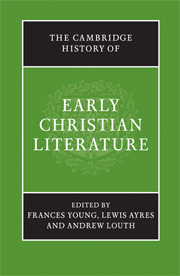Book contents
- Frontmatter
- PART ONE The Beginnings: The New Testament to Irenaeus
- PART TWO THE THIRD CENTURY
- PART THREE FOUNDATION OF A NEW CULTURE: FROM DIOCLETIAN TO CYRIL
- A LITERARY GUIDE
- 21 Classical genres in Christian guise; Christian genres in classical guise
- 22 Arnobius and Lactantius
- 23 Eusebius and the birth of church history
- 24 The fourth-century Alexandrians: Athanasius and Didymus
- 25 Palestine: Cyril of Jerusalem and Epiphanius
- 26 The Cappadocians
- 27 Fourth-century Latin writers: Hilary, Victorinus, Ambrosiaster, Ambrose
- 28 Jerome and Rufinus
- 29 Augustine
- 30 John Chrysostom and the Antiochene School to Theodoret of Cyrrhus
- 31 Cyril of Alexandria
- 32 Hagiography
- 33 Ephrem and the Syriac Tradition
- 34 The literature of the monastic movement
- 35 Women and words: texts by and about women
- 36 Conciliar records and canons
- B CONTEXT AND INTERPRETATION
- Bibliographies
- Index
- Map: The Roman Empire in the late fourth century AD"
- References
27 - Fourth-century Latin writers: Hilary, Victorinus, Ambrosiaster, Ambrose
from A - LITERARY GUIDE
Published online by Cambridge University Press: 28 March 2008
- Frontmatter
- PART ONE The Beginnings: The New Testament to Irenaeus
- PART TWO THE THIRD CENTURY
- PART THREE FOUNDATION OF A NEW CULTURE: FROM DIOCLETIAN TO CYRIL
- A LITERARY GUIDE
- 21 Classical genres in Christian guise; Christian genres in classical guise
- 22 Arnobius and Lactantius
- 23 Eusebius and the birth of church history
- 24 The fourth-century Alexandrians: Athanasius and Didymus
- 25 Palestine: Cyril of Jerusalem and Epiphanius
- 26 The Cappadocians
- 27 Fourth-century Latin writers: Hilary, Victorinus, Ambrosiaster, Ambrose
- 28 Jerome and Rufinus
- 29 Augustine
- 30 John Chrysostom and the Antiochene School to Theodoret of Cyrrhus
- 31 Cyril of Alexandria
- 32 Hagiography
- 33 Ephrem and the Syriac Tradition
- 34 The literature of the monastic movement
- 35 Women and words: texts by and about women
- 36 Conciliar records and canons
- B CONTEXT AND INTERPRETATION
- Bibliographies
- Index
- Map: The Roman Empire in the late fourth century AD"
- References
Summary
The middle to later years of the fourth century witnessed a remarkable proliferation of Christian Latin literature, especially in Italy and Gaul. The earliest Latin poetry and hymns appear at this time, as do the first Latin commentaries on complete books of Scripture. Dogmatic literature abounds in the form of histories and polemical treatises, owing to the controversies surrounding the Council of Nicaea and its creed. The ascetical movement also led to the production of numerous ascetical letters and treatises. Greek philosophical thought, especially Middle Platonism and Neoplatonism, as well as the Platonizing theology of the Greek Fathers, entered the Western literary tradition through the translations and treatises of some of the fourth-century authors under consideration here.
Hilary of Poitiers
One of the great lights of the Gallic Church, Bishop Hilary of Poitiers was born early in the fourth century and became bishop around the year 350. He was exiled by Emperor Constantius II to Phrygia following the Council of Béziers (Baeterrae) in 356 for reasons that remain obscure. The traditional view is that Hilary was exiled for refusing to subscribe to the condemnation of Athanasius and the Nicene faith, but more recently several scholars have suggested that political opposition to Constantius and support of the usurper Silvanus may have led to Hilary’s downfall. Whatever the reasons for his exile, while in the East Hilary became more acquainted with the intricacies of the Arian controversy, particularly the perspective of the homoiousion party, the large number of Eastern bishops who rejected Arianism but who believed the Nicene formula was susceptible to monarchian interpretations.
Keywords
- Type
- Chapter
- Information
- The Cambridge History of Early Christian Literature , pp. 302 - 317Publisher: Cambridge University PressPrint publication year: 2004
References
- 1
- Cited by

